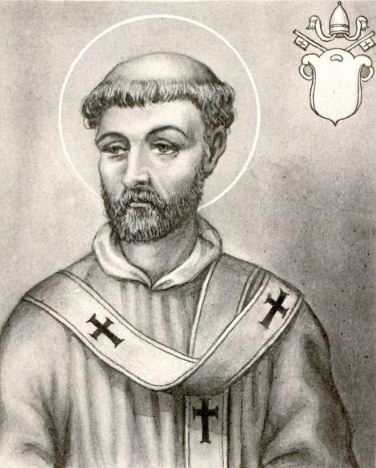The Lives and Times of the Popes - Saint Hyginus – A.D. 139
 Saint Hyginus was born at Athens, and was raised to the papacy by the clergy and the people in A.D. 139. He settled the order of priority among the clergy, which has led to the supposition that he was the founder of the College of Cardinals. The custom of having a godfather and a godmother at the baptismal font, which some have attributed to Hyginus, is stated by Novaes, on the authority of Tertullian, to have been in use prior to the reign of that pontiff.
Saint Hyginus was born at Athens, and was raised to the papacy by the clergy and the people in A.D. 139. He settled the order of priority among the clergy, which has led to the supposition that he was the founder of the College of Cardinals. The custom of having a godfather and a godmother at the baptismal font, which some have attributed to Hyginus, is stated by Novaes, on the authority of Tertullian, to have been in use prior to the reign of that pontiff.
Hyginus excommunicated Cerdon, the author of that heresy which afterwards was known as the Marcionite. This heresy taught that there were two Gods, one good and the other cruel. Cerdon denied that Jesus Christ had ever lived in the flesh, averring that he was only a shadow. This sentence of Hyginus was almost universally approved. Novaes affirms that this pope suffered martyrdom, but Eusebius and Saint Cyprian say that, though he endured much for the sake of the Church, he did not, strictly speaking, suffer martyrdom. He governed the Holy See during three years, eleven months, and twenty-nine days.
Saint Hyginus was buried at the Vatican. We have spoken of the clergy and the people as having elected the pope. The clergy were divided into three classes – priests, heads of the clergy, and the inferior clergy. The priests were the seven suburbicans (afterwards named cardinal-bishops), and the twenty-eight priests who were also called cardinals. The principal clergy, or primates of the Church, were the Primate of the Notaries, or archdeacon, the deputy archdeacon, the treasurer, the Protoscrinarius, the Chief of the Defenders, and the Nomenclator. The rest of the clergy consisted of subdeacons, notaries, and acolytes. The people were divided into three classes – the citizens, the soldiery, and the rest, though they were Christians, were not recognized as either citizens or soldiers.
In the eleventh century, under the reign of Nicholas II, the elective faculty was limited to the principal priests and vicarial bishops of Rome, who were then generally called Metropolitan Cardinals, Cardinal-bishops, and Cardinal-deacons.
- from "The Lives and Times of the Popes", by Alexis-François Artaud de Montor
 Saint Hyginus was born at Athens, and was raised to the papacy by the clergy and the people in A.D. 139. He settled the order of priority among the clergy, which has led to the supposition that he was the founder of the College of Cardinals. The custom of having a godfather and a godmother at the baptismal font, which some have attributed to Hyginus, is stated by Novaes, on the authority of Tertullian, to have been in use prior to the reign of that pontiff.
Saint Hyginus was born at Athens, and was raised to the papacy by the clergy and the people in A.D. 139. He settled the order of priority among the clergy, which has led to the supposition that he was the founder of the College of Cardinals. The custom of having a godfather and a godmother at the baptismal font, which some have attributed to Hyginus, is stated by Novaes, on the authority of Tertullian, to have been in use prior to the reign of that pontiff.